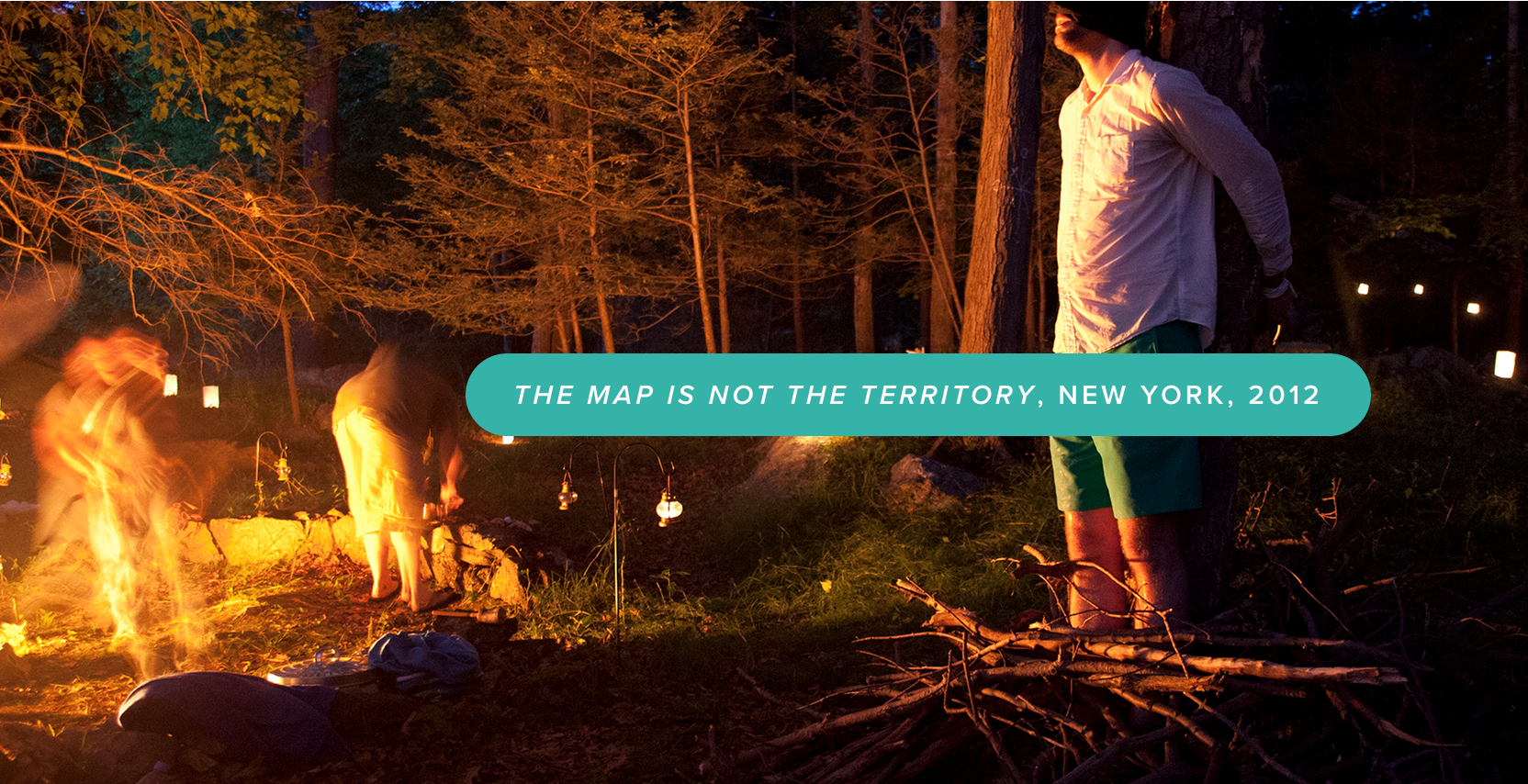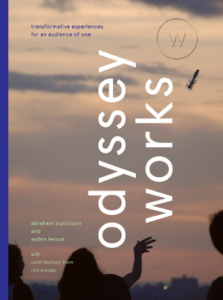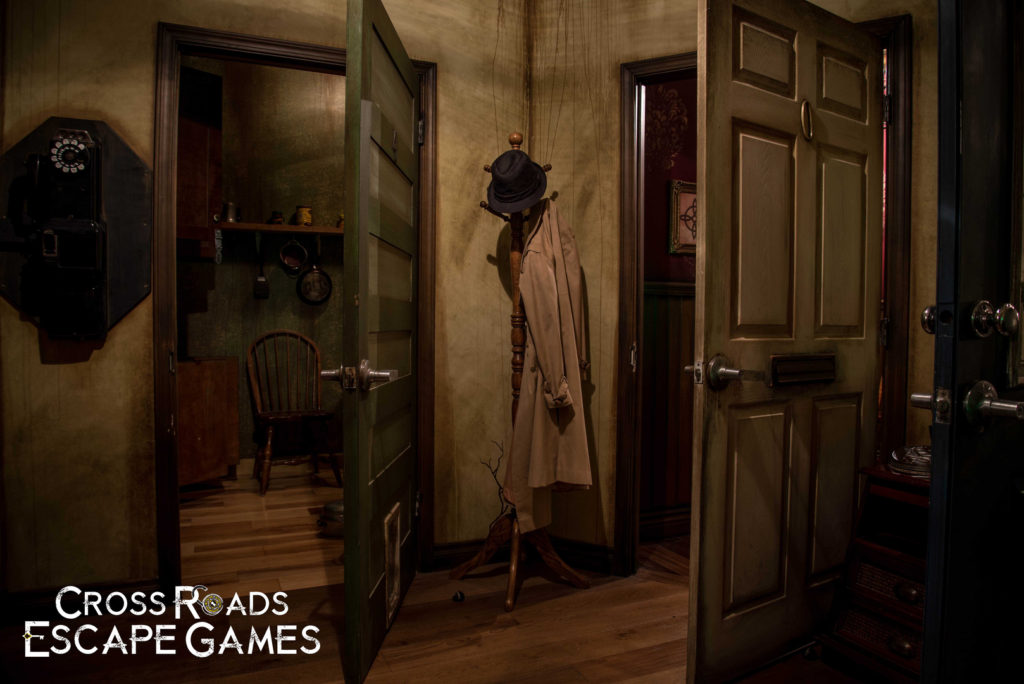I recently had the very good fortune to attend a two-hour workshop by Odyssey Works. And I fell in love. With their approach, with their work, with my partner who, 20 minutes prior to our interview, had been a total stranger.
About Odyssey Works
Odyssey Works started with the question “How could our art have the deepest possible impact on our audiences?” All artists want to move their audience, to have a lasting impact, but without knowing the audience—their struggles, their childhoods, their obsessions and bugbears—it is impossible to guarantee such an impact. Odyssey Works asks, “If our art could change just one life, wouldn’t it be worth it?” And from that resounding YES came a company devoted to designing immersive experiences for one person.
It starts with a long and detailed application—you know you’re signing up for the experience, and you know if you’re chosen. The survey digs into real personal meat: what’s your relationship with your mother? Where do you feel at home? What’s something you do every day that others don’t? What is your relationship with death? Once Odyssey Works chooses their participant, they interview you, family, friends, and enemies, read what you write, read your favorite books, listen to your favorite music, attend your houses of worship, doing everything they can to immerse themselves in your life. They call this “radical empathy.” Naturally, they fall a bit in love!
After studying the participant for months, Odyssey Works asks “What do I wish for this person?” They’re not talking wish-fulfillment, like a new job or a better house, but more along the lines of “I wish you felt a connection to your body” or “I wish you could experience beauty in new ways, seeing beauty even in your tiny apartment.” It’s usually a life-changing wish. With the wish the ultimate goal, they then map the emotional affects they want to achieve in the participant, and then design the experience to achieve those affects.
The Odyssey begins slowly, perhaps with a newly-discovered book by your favorite author that has an uncanny resemblance to some of your life experiences or with a dancer in red on your subway ride to work. Sometimes you’ll meet new people, and they will be part of the Odyssey you experience (note that they never play characters other than themselves; all of the actors stay true to who they really are, but they will tailor themselves to serve a purpose in the experience). The experience then culminates in a single weekend of events—often you’re kidnapped and whisked away someplace else. And you emerge on the other side deeply moved and fundamentally transformed. Guaranteed.

Like so many worthwhile artistic projects, Odyssey Works relies on grants and commissions to keep going, and their many collaborators (from medievalists to chefs) work on a volunteer basis. Odyssey Works does not categorize themselves as “immersive theatre,” although they do use the entire world as their “set,” and an even more profound blurring between what is the real world and what is the artistic world occurs for the participant. So while we may not be completely overlapping in our projects, Odyssey Works has a lot to teach Strange Bird Immersive and other immersive theatre companies.
Six proposals
In their book, Odyssey Works outlines six proposals for artists looking to achieve a similar impact with their audiences…

- Begin with Empathy
- Involve Your Audience Completely
- Stop Pretending
- Design Experiences, Not Things
- Experiment with Form
- Produce, Don’t Reproduce
I highly recommend reading their book from cover to cover. While I must warn that it does sometimes stray from practical language into something more kin to academic art-lingo talk, it’ll undoubtedly inspire any experiential artist to re-examine their work. I sure did!
Take-Away: Personalize it
I was particularly struck with the call to radically personalize the experience. The lack of personalization is a big part of what makes traditional auditorium-stage theatre so static. Everyone is asked to receive the same story and to stay completely anonymous in the dark. In immersive theatre, you exist in the story, you matter to the characters, and you may even affect what happens. Eye contact alone is AMAZING. This is a great beginning. Can we go even deeper than that?
A little personalization goes a long way. In The Man From Beyond, we like to surprise guests with a personalized gift as well as with an intimate tarot reading. Madame Daphne also has the opportunity to learn her guests’ names without much trouble. Odyssey Works reminded me how powerful someone calling you by name can be, and now my character may call out to you for help by name. I’m already noticing that deeper relationships are now possible the moment you introduce a name.
I’m also imagining a show structured around a survey: your answers could set you on a particular story/character track in the show that either appeals to your personality or specifically challenges you to face what you’re uncomfortable with. The Hex Room, created by Cross Roads Escape Games in Anaheim, CA, makes guests take a brief survey to find out what stereotypical horror character they are, and then promptly locks you in a room themed to fit that character. (I am proud to report I’m the detective).

Then She Fell achieves personalization by asking personal-history questions of the audience: “When did you first fall in love?” “Have you ever done something you weren’t supposed to?” Answering these questions unlocks new meaning for the audience.
Each person is an endlessly complex individual, and everyone fundamentally wants “to be seen.” Immersive theatre gives artists the opportunity to give that gift of “being seen” to their audience. There’s a lot of fertile ground to explore here.
Take Away: Design Experiences
I am also moved by the idea that we are designing experiences here, and we should approach our work in those terms. We’re turning flat stories into four-dimensional, fully lived experiences. The experience of the audience is primary.
Actors never want to think in terms of emotions and moods (MOOD is DOOM spelled backwards, as my Meisner acting coach says). But that’s not a rule designers should follow. The best immersive theatre experiences will be carefully crafted with the emotional impacts in mind. Next time I am working on a new immersive experience, I intend to begin with a concrete wish for the audience, and then map out the emotional journey we want the audience to undergo.
We should also be thinking about experiences in more sensory terms as well. In one show, Odyssey Works added mulch to the participant’s secret room, with the explicit goal of triggering the feelings aroused in that room in the participant for years to come whenever he smelled mulch again. YES. Immersive theatre introduces a new design category (and my favorite credit in my own show): scent design.
Life Take-Aways
In the workshop I attended, I asked a stranger five questions, but these questions weren’t about where she works or lives or her opinions of movies or politics. They were meaty questions that established intimacy in a flash. The question “What’s been on your mind lately?” unlocked a staggering amount of emotion and detail. I left wondering if I knew my closest friends in this way. I now want to go ask them all of these questions, and so personalize our relationship more.
Human beings are always designing experiences for each other, from hosting a friend’s birthday party to choosing how to split up the family into separate cars. Odyssey Works calls us to be conscious about these choices, and to design them with an eye to the participant. This is how we can transform experience into a gift.
So get out there, ask the real questions, and design experiences!
For more on Odyssey Works, visit their website.
And buy their book. Seriously, wow.


Okay this company sounds amazing. And expensive.